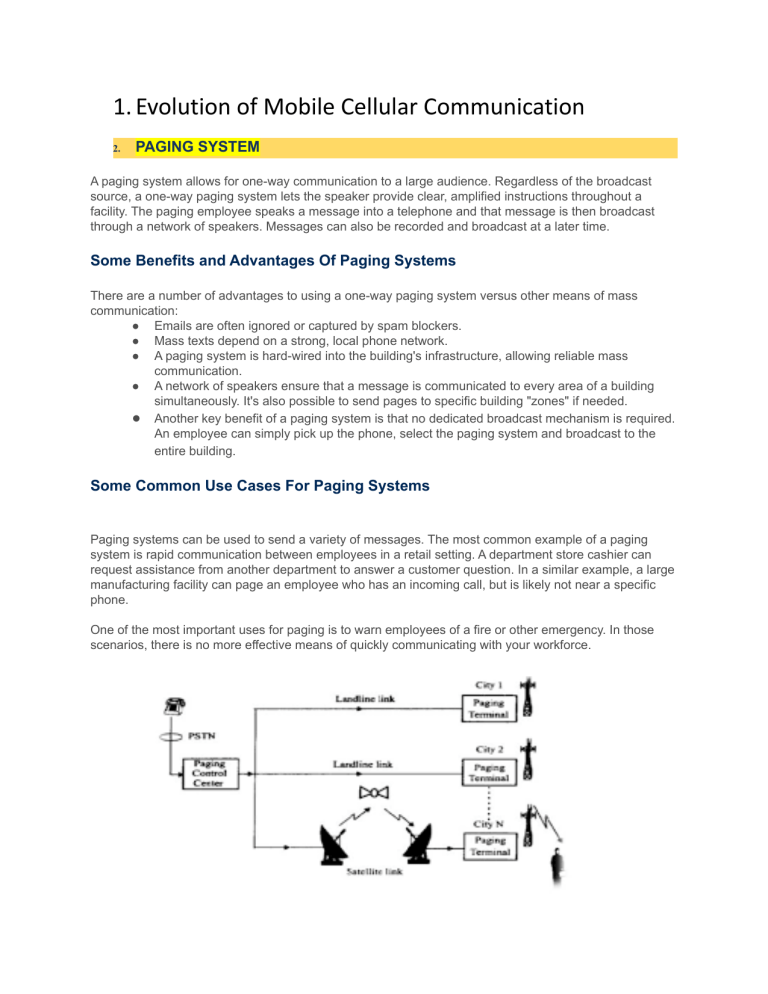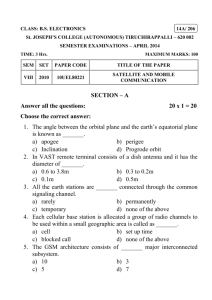
1. Evolution of Mobile Cellular Communication 2. PAGING SYSTEM A paging system allows for one-way communication to a large audience. Regardless of the broadcast source, a one-way paging system lets the speaker provide clear, amplified instructions throughout a facility. The paging employee speaks a message into a telephone and that message is then broadcast through a network of speakers. Messages can also be recorded and broadcast at a later time. Some Benefits and Advantages Of Paging Systems There are a number of advantages to using a one-way paging system versus other means of mass communication: ● Emails are often ignored or captured by spam blockers. ● Mass texts depend on a strong, local phone network. ● A paging system is hard-wired into the building's infrastructure, allowing reliable mass communication. ● A network of speakers ensure that a message is communicated to every area of a building simultaneously. It's also possible to send pages to specific building "zones" if needed. ● Another key benefit of a paging system is that no dedicated broadcast mechanism is required. An employee can simply pick up the phone, select the paging system and broadcast to the entire building. Some Common Use Cases For Paging Systems Paging systems can be used to send a variety of messages. The most common example of a paging system is rapid communication between employees in a retail setting. A department store cashier can request assistance from another department to answer a customer question. In a similar example, a large manufacturing facility can page an employee who has an incoming call, but is likely not near a specific phone. One of the most important uses for paging is to warn employees of a fire or other emergency. In those scenarios, there is no more effective means of quickly communicating with your workforce. HTTPS://WWW.MITEL.COM/FEATURES-BENEFITS/PAGING SYSTEM#:~:TEXT=A%20PAGING%20SYSTEM%20IS%20HARD,BUILDING%20%22ZONES%22%20IF%20NEEDED. 3. Cordless Telephone System 4. Cellular Telephone System 4. Fundamentals of Cellular System Cellular network basics - a summary or tutorial about cellular network basics, detailing the main elements within it BTS, BSC, HLR, VLR, etc. Cellular / Mobile Telecommunications Basics Includes: What is cellular communications Concept of cellular system Radio access network, RAN Base station antenna technology Multiple access techniques Duplex techniques What's inside a cellphone SIM cards Handover Backhaul The network forms the heart of any cellular telephone system. The cellular network fulfils many requirements. Not only does the cellular network enable calls to be routed to and from the mobile phones as well as enabling calls to be maintained as the cell phone moves from one cell to another, but it also enables other essential operations such as access to the network, billing, security and much more. To fulfil all these requirements the cellular network comprises many elements, each having its own function to complete. The most obvious part of the cellular network is the base station. The antennas and the associated equipment often located in a container below are seen dotted around the country, and especially at the side of highways and motorways. However there is more to the network behind this, as the system needs to have elements of central control and it also needs to link in with the PSTN landline system to enable calls to be made to and from the wire based phones, or between networks. Different cellular standards often take slightly different approaches for the cellular network required. Despite the differences between the different cellular systems, the basic concepts are very similar. Additionally cellular systems such as GSM have a well-defined structure, and this means that manufacturers products can be standardised. Basic cellular network structure An overall cellular network contains a number of different elements from the base transceiver station (BTS) itself with its antenna back through a base station controller (BSC), and a mobile switching centre (MSC) to the location registers (HLR and VLR) and the link to the public switched telephone network (PSTN). Of the units within the cellular network, the BTS provides the direct communication with the mobile phones. There may be a small number of base stations then linked to a base station controller. This unit acts as a small centre to route calls to the required base station, and it also makes some decisions about which of the base station is best suited to a particular call. The links between the BTS and the BSC may use either land lines of even microwave links. Often the BTS antenna towers also support a small microwave dish antenna used for the link to the BSC. The BSC is often co-located with a BTS. The BSC interfaces with the mobile switching centre. This makes more widespread choices about the routing of calls and interfaces to the land line based PSTN as well as the HLR and VLR. Base transceiver station, BTS The base transceiver station or system, BTS consists of a number of different elements. The first is the electronics section normally located in a container at the base of the antenna tower. This contains the electronics for communicating with the mobile handsets and includes radio frequency amplifiers, radio transceivers, radio frequency combiners, control, communication links to the BSC, and power supplies with back up. The second part of the BTS is the antenna and the feeder to connect the antenna to the base transceiver station itself. These antennas are visible on top of masts and tall buildings enabling them to cover the required area. Finally there is the interface between the base station and its controller further up the network. This consists of control logic and software as well as the cable link to the controller. BTSs are set up in a variety of places. In towns and cities the characteristic antennas are often seen on the top of buildings, whereas in the country separate masts are used. It is important that the location, height, and orientation are all correct to ensure the required coverage is achieved. If the antenna is too low or in a poor location, there will be insufficient coverage and there will be a coverage "hole". Conversely if the antenna is too high and directed incorrectly, then the signal will be heard well beyond the boundaries of the cell. This may result in interference with another cell using the same frequencies. The antennas systems used with base stations often have two sets of receive antennas. These provide what is often termed diversity reception, enabling the best signal to be chosen to minimise the effects of multipath propagation. The receiver antennas are connected to low loss cable that routes the signals down to a multicoupler in the base station container. Here a multicoupler splits the signals out to feed the various receivers required for all the RF channels. Similarly the transmitted signal from the combiner is routed up to the transmitting antenna using low loss cable to ensure the optimum transmitted signal. Mobile switching centre (MSC) The MSC is the control centre for the cellular system, coordinating the actions of the BSCs, providing overall control, and acting as the switch and connection into the public telephone network. As such it has a variety of communication links into it which will include fibre optic links as well as some microwave links and some copper wire cables. These enable it to communicate with the BSCs, routing calls to them and controlling them as required. It also contains the Home and Visitor Location Registers, the databases detailing the last known locations of the mobiles. It also contains the facilities for the Authentication Centre, allowing mobiles onto the network. In addition to this it will also contain the facilities to generate the billing information for the individual accounts. In view of the importance of the MSC, it contains many backup and duplicate circuits to ensure that it does not fail. Obviously backup power systems are an essential element of this to guard against the possibility of a major power failure, because if the MSC became inoperative then the whole network would collapse. While the cellular network is not seen by the outside world and its operation is a mystery to many, the cellular network is at the very center of the overall cellular system and the success of the whole end to end system is dependent largely on its performance. 5. FDMA Advantages and Disadvantages of Frequency-division multiple access (FDMA) Frequency-division multiple access (FDMA) : Frequency-division multiple access is one among the only multiple access methods. During this method, the channel bandwidth is subdivided into a variety of sub-channels. This multiple access method used for voice and data transmission. During this method the general channel bandwidth is being shared by multiple users, therefore the variety of users can transmit their information simultaneously. The adjacent frequency bands within the FDMA spectrum are likely to interfere with one another. Therefore, it’s necessary to incorporate the guard bands between the adjacent frequency bands. No code words and synchronization are required. Power efficiency reduced using FDMA, it’s an old and proven system and used for analog signals. Advantages of FDMA : 1. 2. 3. 4. 5. 6. 7. 8. 9. 10. 11. Use of efficient numerical codes increases the capacity. It reduces the worth. Lowers the inter symbol interference (Equalization isn’t required). An FDMA system is often easily implemented, system are often configured so, the improvements in terms of speech encoder and bit rate reduction could even be easily incorporated. Simple to implement, from a hardware standpoint. Fairly efficient with a little base population and when traffic is constant. FDMA includes its applicability to both analog and digital transmission systems, the actual fact that no special coding is required, the allocation of capacity is simple, no network synchronization or timing is required, which the baseband signal are often recovered using simple and cheap receiver equipment. Reducing the knowledge bit rate and using efficient digital codes can obtain capacity increases. As FDMA systems use low bit rates (large symbol time) compared to average delay spread, they reduce the worth, and there is low Inter Symbol Interference (ISI). There is hardly any equalization required. Technological advances required for implementation are simple. A system is often configured so as that improvement in terms of speech coder bit-rate reduction could be readily incorporated. Disadvantages of FDMA : 1. Due to the simultaneous transmission of a large number of frequencies, there is a possibility of inter modulation distortion at the transponder. 2. It is suitable only for analog signals. 3. Storage, enhancement of signals is not possible. 4. The large bandwidth requirement for transponders. 5. Guard bands may waste capacity. 6. It requires RF(Radio Frequency) filters to meet stringent adjacent channel rejection specifications. This may increase the cost of the system. 7. Network planning is cumbersome and time-critical. 8. There is not much flexibility so, need to slowly change already assigned traffic patterns. 9. The carrying capacity of traffic is relatively low. 10. In a general system, because the channels are assigned for a single user, idle channels add to the spectrum. 11. Frequency planning is time-consuming. 12. Required multi-channel receivers that are expensive. 13. The highest bit rate per channel is fixed and small. 14. Hardware involves narrowband filters, which cannot be realized in VLSI. 6. TDMA Advantages and disadvantages of TDMA TDMA full form is Time Division Multiple Access uses time instead of frequency. It is used to facilitate channel sharing without interference. Different user shares the same time slot of the complete time available. Each user to allocate a time slot in which the user can access the channel and in each slot, only one user is allowed to transmit or receive. TDMA was more used by Europe, Japan, and Asian countries, whereas CDMA is widely used in North and South America. But nowadays both technologies are very popular throughout the world. Advantages of TDMA : ● ● ● ● ● ● ● ● ● ● ● TDMA can easily adapt to the transmission of data as well as voice communication. It has the ability to carry 64 kbps to 120 Mbps of data rates. No interference from simultaneous transmission. TDMA is the cost-effective technology to convert an analogue system to digital. Share a single carrier frequency with multiple users Mobile assisted handoff possible TDMA provides the user with extended battery life since transmitting the only portion of the time during conversations Flexible bit rate No frequency guard band required No need of a precise narrowband filter TDMA separates users according to time ensures that there will be no interference from the simultaneous transmission. ● ● ● ● TDMA allows the operator to do services like fax, voiceband data, SMS as well as applications such as multimedia and video conferencing. TDMA offers substantial savings in base-station equipment, space, and maintenance, an important factor as cell sizes grow ever smaller. Dual-band 800/1900 MHz. It is the only technology that offers an efficient utilization of hierarchal cell structures like pico, micro, and macro. Disadvantages of TDMA : ● ● ● ● ● ● ● ● ● In TDMA each user has a predefined time slot so that users roaming from one cell to another are not allotted a time slot. Thus, if all the time slots in the next cell are already occupied, a cell might well be disconnected. In the same way, if all the time slots in the cell in which a user happens to be in are already occupied, a user will not receive a dial tone. It is subjected to multipath distortion. A signal coming from a tower and receive to handset might come from any one of several directions so on the road signal bounced off several different buildings before arriving which can cause interference. Network and spectrum planning is intensive. Too few users result in ideal channels rural versus urban environment. High synchronization overhead. Frequency/slot allocation is to be complex in TDMA. Equalization was necessary for high data rates. Demands high peak power on the uplink in transient mode. Signal processing is required for matched filtering and correlation detection. 7. CDMA advantages and disadvantages The term CDMA full from is Code Division Multiple Access. It is one type of cellular technology in which two main system Base system and mobile subscriber or users. It allows multiple transmitters to transmit information over a single channel simultaneously. CDMA system works based on spread spectrum concept. This article gives information about the advantages and disadvantages of CDMA to know more about CDMA technology. Advantages of CDMA : ● ● ● ● ● ● ● ● CDMA channel is not easily decodable hence it offers increases cellular communication securities Call quality is better with more consistent sound as compared to GSM Less interference due to hand off features reduces call dropping Gives better coverage and needs few antenna sites and also consumes less power Increase user capacity because of more users per MHz of bandwidth than any other system so that it has 4 to 5 times capacity than GSM Better multipath performance The frequency reuse plan is easier to manage Smaller phones ● ● ● ● ● ● ● ● ● ● ● ● ● Greatest spectrum efficiency Low power requirement Increase efficiency as it can serve more users High voice quality as well as signal quality Flexible allocation of resources Operate at a very low power level CDMA does not require any synchronization It has many numbers of users can share in the same bandwidth Efficient practical utilization of fixed frequency spectrum No sense of handoff when changing cells Easy to add many numbers of users Increase user resources Impossible for hackers to decipher the code sent Disadvantages of CDMA : ● ● ● ● ● ● ● ● ● ● Time synchronization is required It can't offer international roaming, a large GSM advantage The CDMA system performance degrades with an increase in the number of users A network of CDMA is not mature because it is relatively new with GSM In while we are using CDMA, code length can be carefully selected, because it can induce delay When the number of users increases, the overall quality of service decreases. Self-jamming problem The near-far problem arises when we are using CDMA techniques Higher cost due to the greater equipment Reduce capacity because gradual transfer increases the use of radio resources



